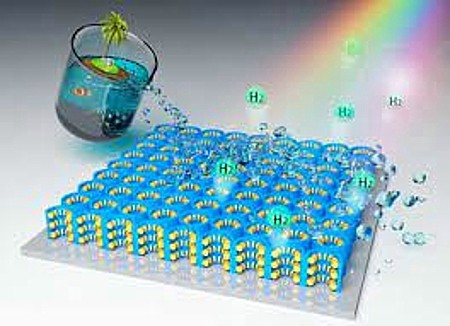
A University of Central Florida (UCF)research team has invented a nanoscale material that can split seawater into oxygen and hydrogen using electrolysis. Their invention was recently described in a paper entitled, Dual-Doping and Synergism toward High-Performance Seawater Electrolysis appearing in the July 8, 2021 issue of the journal Advanced Materials. Prior to this discovery, seawater electrolysis was problematic, and expensive using platinum-group-metals-based filtering technologies.
The UCF researchers developed an alternative made from iron with phosphor dual-doped nickel selenide nanoporous film that in initial testing has demonstrated stability and long-duration capability which may prove to be an energy industry gamechanger.
In a July announcement from the University, Yang Yang, Associate Professor in the NanoScience Technology Center is quoted as stating, “This development will open a new window for efficiently producing clean hydrogen fuel from seawater.” He continues, “The seawater electrolysis performance achieved by the dual-doped film far surpasses those of the most recently reported, state-of-the-art electrolysis catalysts and meets the demanding requirements needed for practical application.” In a 200-hour test of the film, it held up producing hydrogen from seawater continuously. The film is not expensive to produce and is scalable for industrial applications.
The hydrogen produced using this nanofilm is classified as green. Electrolysis is the preferred route to go in producing hydrogen because there are zero emissions if the energy source is not fossil-fuel-based. That’s why the green hydrogen classification, as opposed to blue and grey hydrogen, is preferred.
If unfamiliar with these classifications of hydrogen fuels, blue hydrogen gets produced from fossil fuels when the resulting carbon emissions are captured and sequestered. Grey hydrogen produced from fossil fuels allows carbon emissions to get into the atmosphere. The fossil fuel industry, in its greenwashing efforts and to ensure continued profits from developing new fields to harvest, wants the public to buy into hydrogen produced from oil and gas.
In a world turning away from the burning of fossil fuels because of climate change, hydrogen from seawater would be a breakthrough of global significance. Hydrogen is ideal alternative energy for use in transportation, buildings, and homes where it can be used to recharge fuel cells or if compressed used for heating. Hydrogen, as opposed to natural gas, can be used by utilities in power plants as a backup or supplement to renewable energy generation from wind, solar, tidal and wave sources.
Yang’s research team’s expertise in advanced materials with application for use in renewable energy devices, environmental science, and smart electronics is focused on novel cutting-edge technologies that are much needed over this next decade in our fight to keep atmospheric warming from exceeding the 1.5-Celsius threshold established by the IPCC and Paris Climate Agreement and to stabilize the planet’s climate future.








